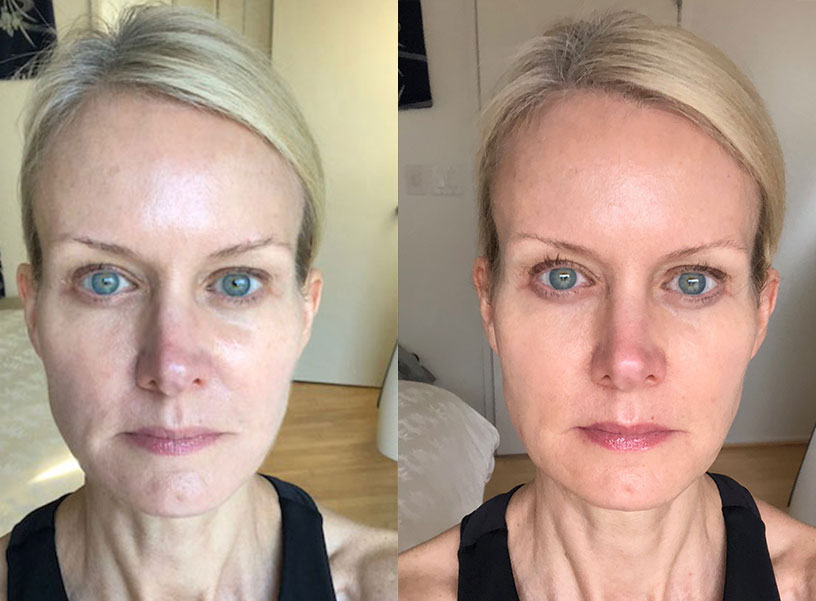Spend or Skip? Vintner's Daughter Serum (6-Week Update)
I’ve just passed the six-week mark of my Vintner’s Daughter Serum road-test—and I’ve also come to the bottom of my bottle. By my math, that means one bottle lasts just under two months, or it'll take seven bottles to get you through a year. At $185/bottle, that’s over $1200 annually…on a single product.
By comparison, my generic tube of tretinoin (a.k.a. Retin-A) runs me about $150. And it lasts me ten to twelve months.
So, the price of Vintner's Daughter does give me pause. I might still rationalize the cost, however, if the results were truly remarkable—and if the serum’s supposed myriad benefits (firming, smoothing, acne-fighting, etc.) enabled me to skip most other skincare, save sunscreen and a cleanser. Then the $1200+ would be easier to stomach.
This, alas, for me, was not the case. As I reported at the 10-day mark, using the serum made my skin flakey. And the peeling (primarily on my forehead) never really went away.
Also at the 10-day mark, I noted that my pores appeared smaller and my T-Zone less shiny. I now think that period was actually a precursor to dehydration, as my skin became increasingly tight and sensitized the longer I used Vintner's Daughter. And that vulnerability left me looking wind-whipped whenever I went for a run outside. (I'm training for a half marathon so not running wasn't an option.) By week three, my skin had become so chapped and blotchy, I cheated and introduced two skin-healing products to my regimen: Epionce Medical Barrier Cream, which I slathered on after Vintner's Daughter and before my Elta MD Sunscreen during the day, and Dr. Brandt HydroBiotic Recovery Mask, which I layered over Vintner’s Daughter before bed.
These additions soothed my skin within a few days, and I give them most of the credit for the fact that my complexion looks fairly clear and calm in my final photo below (the one on the right). My skin is still a little pink, which might have been a benefit if it looked like radiance. But prior to using the Epionce and Dr. Brandt products, the rosiness bordered on rosacea-like.
VINTNER'S DAUGHTER 6-WEEK ROADTEST: Makeup-free photos show very little difference in my complexion from start (left)...to six weeks (right). My skin tone is a little pinker (thanks primarily to increased sensitivity), and my skin finish does seem more matte/less dewy (it's definitely dryer). Any other changes you see are most likely attributable to variations in the morning light, as I took these 8 a.m. selfies next to a window!
One other thing to note: For the first time in years, I also battled two painful acne cysts. Both popped up along my jawline and stayed put for more than two weeks. Maybe their arrival had nothing to do Vintner’s Daughter (and everything to do with being perimenopausal). But once I added the Epionce and Dr. Brandt products to my regimen, the cysts softened and went away…and they've not recurred.
Thus, after six weeks of use, I'm disappointed to report that I was underwhelmed by Vintner’s Daughter Serum. Although I liked the experience of using it: It does smell wonderful, feels luxurious, looks chic sitting on my vanity and, at least initially, simplified my skincare routine, it also made no discernible improvements to my complexion and, in fact left me dryer and more easily-irritated.
The love Millennial bloggers have given this product suggests to me that it's probably better suited to thicker, oilier, rarely-sensitized skin that's showing only early signs of aging. I'll be happily returning to my clinically-proven Retin-A, Beauty Rx Glycolic Pads, and a new deeply-hydrating (but not greasy) oil from Loli, the Tea Seed Elixir.
Was your experience with Vintner’s Daughter different than mine? I’d love to hear about it, good or bad—or tell us all in the Comments, below.
Why did I try Vintner's Daughter? Read this





